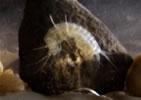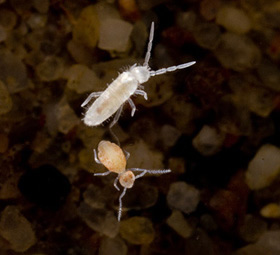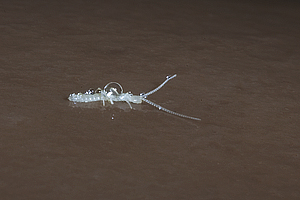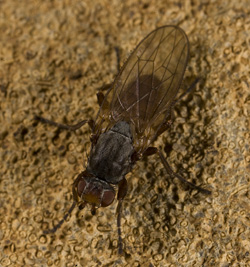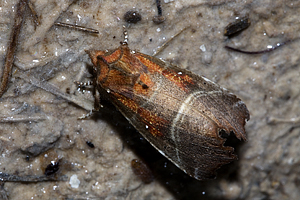There are many cave species in this group including some troglobites.
SPRINGTAILS
The springtails (in the Collembola group) are an ancient group of arthropods, similar forms have been found as fossils that are around 400 million years old. They are wingless ground dwelling insects that require high humidity. Many species have been found in Welsh caves. They are called springtails due to their ability to leap about with the aid of a trigger or ‘spring’. Soil and underground species appear to have evolved a smaller spring, shorter legs and antennae, a reduction in eyes and loss of pigment. They feed on fungal mycelia, bacteria, decomposing plant and animal material.
|
Two species of springtail on the surface of a gour pool in Ogof Ffynnon Ddu 1. The smaller one (Arrhopalites sp.) is 1mm in length and jumps readily. |
Springtails are most easily found on the surface of pools, some are so small (1mm) they will look like specks of white dust to begin with, but if you observe them for perhaps a minute one might leap a couple of inches – enough to convince you that it is actually alive. They are so light and small they can move about on top of the surface film of the water. Best places to look are still pools and damp mud banks. Not all springtails are willing to jump, some walk about on the surface as if they are grazing.
Tomocera minor (a relatively large 4.5mm) is common on mud banks and feeds on fungi. It lives in the soil but moves downwards during cold weather.
Folsomia sp. are found near the entrance or where the surface is not far above. They can leap a short distance (c 1cm). Folsomia candida is found around the world and can survive underwater where the oxygen levels are low.
Deeper underground the blind, white, rod shaped, sluggish Oligaphorura (=Onychiurus) schoetti (1.7mm) might be seen on pool surfaces with the more active Isotoma sp.. Oligaphorura schoetti is a true troglophile and all records are from caves where it is quite common.
The smaller pink, globular, jumping Arrhopalites pygmaes is often found on pool surfaces, but not with O. schoetti. Almost all the UK records are from caves.
The grey brown Pariosotoma notabilis (1.4mm) is found deeper underground.
Schaefferia emucronata is common in caves in the UK (although the taxonomy of the genus and group are still unclear).
DIPLURA
Diplurans ('two tails') are primitive eyeless insects with segmented antennae that generally live underground in soil and leaf litter. They resemble white earwigs and live on prey and dead organic matter including springtails and fungi. They are unusual in that they are able to regenerate lost body parts. On some species the tails (cerci) are used as pincers, the one in the photograph has very small tails and long antennae and has a droplet of water on its back.
|
Diplura on wet flowstone. These can also be seen on the surface of the pools in the high level passage of Ogof Clogwyn (if you get there first!). |
DIPTERA (TWO WINGED FLIES)
Diptera is an Order, their hind wings are modified into a pair of balancing organs called halteres. Many examples of Diptera are found in caves but most are visitors. The flies are often found in the same place year after year, and the Families represented in caves are described below.
There are two major groups or sub-orders: The Nematocera and the Brachycera.
SUB ORDER NEMATOCERA ‘thread horns’ are recognized by their elongated bodies and feathery antennae as represented by mosquitoes, gnats, midges and crane flies. Many of these swarm.
Family MYCETOPHILIDAE or Fungus gnats (their larvae feed on fungi). They are very delicate insects with long, slender antennae and long legs, especially the back ones. Fungus gnats (Mycetophilidae) such as Speolepta leptogaster are numerous in caves, some consider it a troglobite as the larvae has not been found outside of cave-like habitats. The adult looks like a olive-brown miniature crane fly with long legs. The yellow or brown headed transluscent larva (14mm) live in a web of thin threads (looks a bit like a sheet spiders web), and probably live on bacteria and fungi. The tangled mass of threads is to keep the insect from touching the walls, becoming wet and then falling prey to fungi although it may be to trap fungi and other organic material as the larvae eats the web and anything in it. You are most likely to see the fine small strands of the web against the roof or wall, sometimes with a larvae moving along the web. The adult is rarely seen as it makes its short flights from point to point but this may be explained by the fact it does not live very lon. They can be seen in the roof of the Great Bedding Cave of Porth yr Ogof, a habitat that completely floods from time to time.
Family SCIARIDAE Sciarid flies (dark winged fungus gnats) e.g. Bradysia sp have a black body and smokey wings (male), the adults are much more common than larvae (unlike Speolepta). Little is known about these flies. The adults (3mm) have large eyes and are a bit like a mosquito with relatively long legs and wings, beaded antennae and are weak flyers. The black headed, 12 segmented, white semi-transparent larvae (6mm), spins threads for a cocoon and may make a simple web. The larvae feed on fungi and the adults feed on decaying plant and animal material. The remains of the adult are often seen covered in fungi.
In Wales Sciara sp. and Bradysia sp. have been found in Tunnel (Cathedral) Cave.
Family TRICHOCERIDAE Crane Flies. The Winter gnat or crane fly Trichocera maculipennis (8mm) can be found quite deep underground in large cave systems such as Agen Allwedd and Ogof Ffynnon Ddu along with its yellowish larvae. The adult is widely distributed but rarely seen, the larvae are attracted to baits such as rotting meat. It looks like a very small, delicate crane fly.
Other Craneflies visit the threshold in summer; they do not feed as adults. The crane fly Limonia nubeculosa is often found in cave thresholds as a summer visitor – it rests with its speckled brown wings covering its abdomen unlike many crane flies. Outside it is found all year round.
Family SIMULLIDAE black flies
Blackfly (Simulium sp.) larvae are washed in by surface streams. They can be seen anchored to the rocks in the fast flowing streams trying to catch debris as it floats past.
Adult blackfly are among the flies in the Great Bedding at Porth yr Ogof.
Famly CHIRONOMIDAE includes the non-biting midges e.g. Chiromomid blood worm larvae.
The majority of flies in the Great Bedding at Porth yr Ogof are species of Chironomid fly.
Family CULICIDAE e.g. Common Mosquito Culex pipiens. Those in caves are mostly inseminated females overwintering in the thresholds. They leave the cave in spring for a blood meal, usually from a bird (not from humans). There are several generations a year.
SUB ORDER BRACHYCERA have a more roundly proportioned body and much shorter antennae.
Family HELEOMYZIDAE
One of the Marsh flies Heleomyza captiosa is a common visitor to the threshold – they arrive in autumn and remain until starvation or fungal attack. Maybe they settle somewhere dry in the dark zone in winter and get caught out as air current reverses in summer with the corresponding rise in humidity and condensation. In some caves they are present all year so it is unclear why they visit the caves. This dampness is ideal for the fungi to attack them. The small adults are found all year round in the cave, often in shaded areas near rotting matter, but the reason why is not clear. It is probable that many of the recordings of H. serrata are actually H. captiosa, they are identical to the naked eye. The larvae feed on sheep droppings and so they are sometimes known as dungflies (true dung flies are in the Scathophagidae family). The adult Heleomyzidae flies are predators on other flies. Heleomyzids have been recorded from many caves in the region. Scoliocentra sp., another Heleomyzid, is also found in the threshold.
|
Marshfly Heleomyza serrata/captiosa, Ogof Tardiadd Rhymney |
FAMILY PHORIDAE Scuttle or Coffin flies These run about and are reluctant to fly. They get their name from the scuttling behaviour and seeming reluctance to fly, and the close association with corpses.
ORDER LEPIDOPTERATA (BUTTERFLIES AND MOTHS)
The Tissue moth (Trichosa dubitata) and the Herald moth (Scoliopteryx libatrix) are common in cave entrances such as Eglwys Faen. Both overwinter in the cave (they do move around the cave during this time). The Tissue moth settles closer to the entrance and lower down the wall than the Herald moth. The caterpillar eats buckthorn and blackthorn.
The Herald moth stays underground for up 10 months, it is often found in the dark zone beaded in moisture. It is unlikely the 10 months is all hibernation, part of this time could be to allow the ovaries to develop. It keeps its head pointing away from the light. The caterpillar eats willow and poplar.
|
Herald moth in Eglwys Faen. |
ORDERS EPHEMEROPTERA (Mayfly), PLECOPTERA (Stonefly), TRICHOPTERA (Caddis Fly)
These Orders generally have two pairs of wings although the hind pair is sometimes much reduced in size or missing as in some mayfly. Mayflies, stoneflies and caddis flies have nymphs that live in streams, some have several generations an year while some larger species have nymphs that live in the streams and rivers for a few years before becoming an adult fly. The adults may only live for a few days. Their nymphs are washed into caves from the surface and a variety of species can be found in the streams of the caves, sometimes a considerable way underground.
MAYFLY e.g. Baetis and Ecdyonorus are common in allogenic cave streams. Adult mayflies hold their wings upright at rest and have two or three tails. The nymphs have three tails.
STONEFLY Dinocras cephalotes is the most frequently recorded, others are Nemouras cambrica and Leuctra sp. Adults hold their wings flat along the back, or in the Leutricidae family (needle flies), rolled around the abdomen. The larva have two long tails, the adults look like a winged larva although some species lose the tails.
CADDIS FLY Plectrocnemia conspersa and P. geniculata larvae spin nets in the stream to capture prey. They can make a number of different types of net depending on the water conditions. The variable net-spinning behaviour enables the caddis population to exploit a wide range of prey and microhabitats. If a sufficient food supply is washed in by the stream these nymphs and larvae can continue to survive underground but as soon as they metamorphose into winged adults they will die as the adult stages often rely on plants for feeding. Adult Philopotamus montanus, yellow spotted sedge, are not uncommon in caves.
Adults of the large buff coloured caddisfly Stenophylax permistus use the cave threshold as a resting stage for part of the summer (diapause).
COLEOPTERA (BEETLES)
Several species of beetle are cavernicoles. A variety of species can potentially be found in the threshold of caves but the ones most likely to be found deeper underground are members of the ground beetle (Carabidae) and rove beetle (Staphylinidae) families (there are over 980 species of rove beetle recorded in the UK).Members of the Choleva genus are found in the threshold feeding on detritus and fungi. During summer they create a clay cell and re-emerge in autumn (a summer diapause).
A little orange beetle called Trechoblemus micros has blind larvae and has been found in Otter Hole and Ogof Ffynnon Ddu. The adult has eyes and does not appear to have evolved for a life in the dark – even though it is only found in caves. It is a predator and relatively common in British caves.
The rove beetles have a number of species found in Wales - Quedius mesomelius and Lesteva pubescens have both been found in Porth yr Ogof. This rove beetle was photographed in Eglwys Faen.
Water and diving beetles are found in caves, this photograph is of a diving beetle found in a gour pool at the bottom of the creek in Porth yr Ogof, probably washed in during a flood.
OTHER INSECTS
FLEAS are common on bats. They are small wingless parasites noted for their ability to leap. |

